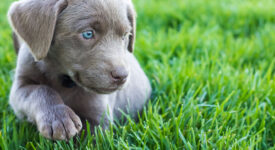Dogs can experience anxiety in many of the same ways that people do. They may become clingy, they may start to hide, or they may be more aggressive than normal. Many dogs who are experiencing anxiety will engage in destructive behavior as well. It’s important that if you see any of these signs, you should speak to your veterinarian to learn how you can help your dog through this difficult time.
Anxiety is a common feeling for people, and it’s also common in dogs. In fact, anxiety in dogs can manifest in many of the same ways it does in people. If you’re concerned that your dog or puppy may be experiencing anxiety, here are some signs to look out for. Knowing what to look for can help you get your furry friend the help he or she needs.
Signs of Stress and Anxiety in Dogs:
Common signs of stress and anxiety in dogs include panting, drooling, pacing, whining, barking, and hiding. If your dog shows any of these signs, it’s important to determine the cause of the stress and take steps to address it. Some common causes of stress in dogs include loud noises, fireworks, new environments or people, separation from their guardians, and changes in routine.
If you’re unable to determine the cause of your dog’s anxiety, or if the anxiety is severe enough to cause significant behavioral problems or physical health issues, please consult with a veterinarian or behaviorist for help.
How to Help an Anxious Dog?
There are a few things that can be done to help an anxious dog. One is to provide them with a quiet and safe space where they can relax. You can also try training your dog to respond to certain commands that will help calm them down, such as “sit” or “stay.” Additionally, you can work on building up your dog’s confidence by rewarding them for exhibiting calm behavior. Finally, you may want to consult with a professional animal behaviorist if the anxiety is proving too difficult to manage on your own.

How do you know if your dog has anxiety?
There are a few ways to tell if your dog is anxious. One common sign of anxiety in dogs is when they pace back and forth or groom themselves excessively. Dogs may also vocalize more than usual when they’re anxious, or they may urinate or defecate indoors. If you think your dog may be experiencing anxiety, it’s best to consult with your veterinarian to rule out any underlying health issues and to discuss treatment options.
What are the first signs of stress in a dog?
Early signs of stress in dogs can be subtle and easily missed. Watch for the following cues that your dog may be anxious or stressed:
- Panting or heavy breathing
- Frequent yawning or lip licking
- Trembling or shaking
- Restlessness
- Unwillingness to eat or drink
- Changes in bowel movements or urination habits
- Whining, Howling, Barking, Excessive Shedding
These are just a few signs that your dog may be experiencing stress. If you notice any of these behaviors, it’s important to take steps to help your dog feel more comfortable and relaxed.
Signs of Anxiety in Dogs and Puppies Result
There are a few early signs you can look out for to determine whether or not your dog is experiencing anxiety. Those include vocalizing more frequently, pacing, excessive grooming, and defecating or urinating in the house. If these things sound familiar to you and your pet, it’s best to bring your dog in for a checkup at the vet.
F.A.Q
Can puppies have anxiety?
In short, it seems as though anxiety in puppies can be a difficult problem to remedy if it can even be remedied at all. Whether a puppy’s problem is with separation or social anxiety or noise, if those problems make living with your pup a nightmare then it might be worthwhile to seek help from a vet or dog trainer. There are many different things you can do to help with the anxiety (and of course, to help train the puppy itself). You just have to make sure that those methods correspond with how your puppy actually acts when experiencing its triggers.
What dog breeds have the most anxiety?
It’s also worth noting which dog breeds are least likely to have anxiety. Despite having a low fear quotient overall, Labradors were particularly unlikely to show anxiety-like behavior in any of the conditions we tested them in. Mixed breed dogs also had a low fear quotient, and unsurprisingly, no purebred or mixed breed dogs showed a significant amount of separation anxiety. The presence of fearful or anxious behavior is always relative when looking at breeds, but there are certain behaviors that seem more common among some breeds than others.







